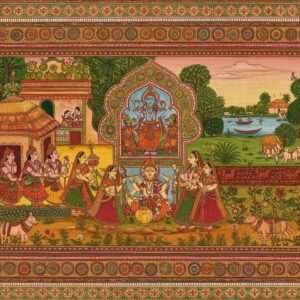
Kuchipudi, a vibrant classical dance form originating from India, beautifully intertwines tradition with modernity. This captivating dance form allows dancers to eloquently express stories through the use of Devata Hastas, symbolic hand gestures that represent various deities. These gestures are pivotal in the art of storytelling within Kuchipudi, forging a link between the performers and divine elements while preserving India’s rich cultural heritage.
Understanding the Significance of Devata Hastas in Kuchipudi
Devata Hastas, meaning “divine hand gestures,” are integral to Indian classical dance. In Kuchipudi, they serve as a powerful medium for conveying emotions and narrating intricate stories, enriching both the visual and spiritual dimensions of the performance. By employing these Devata Hastas, dancers embody divine qualities, establishing a profound connection with their audience. These gestures distinguish themselves from other hand movements in classical dance due to their unique symbolic meanings. Each Hasta possesses a specific purpose and application, making them indispensable in Kuchipudi performances. They breathe life into the dance, empowering performers to communicate complex narratives with grace and authenticity.
Looking to enhance your understanding and practice of Hindu rituals? Visit poojn.in for a wide selection of puja items like fountain pen ink specifically designed for ceremonial use.
Exploring the Nuances of Devata Hastas
Delving deeper into the world of Devata Hastas reveals their profound impact on Kuchipudi. They are not merely physical movements; they are a language of devotion, spirituality, and tradition. Each gesture carries a rich history and symbolism, allowing dancers to express a wide spectrum of emotions and narratives. The seamless integration of Devata Hastas into the dance elevates Kuchipudi to an art form that transcends mere entertainment, transforming it into a spiritual experience.
Prepare for upcoming pujas with ease. Browse our curated collection of puja kits and essentials at poojn.in. From Saraswati Puja Dashakarma Kits to a variety of other items, we have everything you need for a fulfilling spiritual experience.
Embracing the Legacy: Devata Hastas and Cultural Preservation
The art of Kuchipudi, with its exquisite Devata Hastas, continues to inspire and connect us to our rich cultural heritage. These hand gestures are more than just movements; they are a living testament to India’s artistic and spiritual traditions. By understanding and appreciating Devata Hastas, we actively contribute to the preservation of this vibrant classical dance form. As we embrace these timeless expressions, we honor our past and carry its legacy gracefully into the future. Whether you are a seasoned dancer, an enthusiastic spectator, or simply curious about Indian culture, appreciating Devata Hastas allows you to engage with a tradition that spans generations.
Illuminate your puja space with our exquisite selection of diyas and battis. Explore our range at poojn.in and discover the perfect additions to your spiritual practice.
Frequently Asked Questions about Devata Hastas
What are Devata Hastas?
Devata Hastas are symbolic hand gestures used in Indian classical dance, particularly Kuchipudi, and other traditional rituals. Each gesture corresponds to a specific deity, a divine concept, or an element of storytelling, adding layers of spiritual depth and meaning to performances and ceremonies.
Why are Devata Hastas important in rituals and dance?
Devata Hastas carry profound cultural and spiritual significance. They are instrumental in conveying stories and expressing complex emotions in dance while also symbolizing divine blessings and invocations in rituals. This dual role bridges the gap between the performer or participant and the rich tapestry of Indian traditions.
How can I learn the Devata Hasta shloka?
Learning the Devata Hasta shloka involves studying classical dance under the guidance of a guru or exploring traditional Indian texts that describe the mudras and their corresponding verses. Numerous online resources and tutorials can also provide valuable support in understanding and mastering the shlokas and their deeper meanings.
Where can I find Devata Hastas images?
Visual representations of Devata Hastas can be found in specialized dance manuals, online image galleries dedicated to Indian classical arts, and cultural websites. These images serve as valuable learning aids, providing detailed views of the correct posture and associated meaning of each hand gesture.
Can I use Devata Hastas in daily prayers?
Absolutely, incorporating Devata Hastas into daily prayers can enrich your spiritual connection. These gestures are believed to channel divine energy and focus, enhancing the devotional aspect of prayer rituals. They can also add a deeper layer of meaning to your personal spiritual practice.
Are Devata Hastas unique to a specific Indian dance form?
While Devata Hastas are prominently featured in Bharatanatyam and Kuchipudi, they are also employed in various other classical Indian dance forms. However, it’s important to note that each dance style may have its unique interpretations and applications of these gestures, reflecting the specific cultural context of the dance form.
What materials can help me practice Devata Hastas at home?
A range of resources can facilitate your practice of Devata Hastas at home. These include comprehensive books on mudras and Indian classical dance, online video tutorials that demonstrate the gestures step-by-step, and interactive dance tutorials that offer personalized feedback and guidance.
How do Devata Hastas enhance a dance performance?
Devata Hastas contribute significantly to the richness of a dance performance by weaving layers of meaning and storytelling into the choreography. They empower dancers to express a wider range of emotions and connect with the audience on a deeper cultural and spiritual level. The precise execution of these hand gestures adds a captivating visual element to the performance.


